2.1 MENDELIAN GENETICS
Gregor Mendel was a monk at the monastery of St. Thomas at Brünn (now Brno in the Czech Republic). Renowned for teaching the sciences, the monastery sent Mendel to the University of Vienna in 1851, to obtain his teaching credentials. Although Mendel failed his final exams, he returned to the monastery and began a 10-year program of experiments that were so well conceived and executed that his results form the cornerstone of modern genetics.

Gregor Mendel, 1822–1884
In Mendel’s time, plant hybrids were highly desired for their unique ornamental varieties. But the inheritance of colorful hybrid flower patterns was perplexing and unpredictable. The inability to decipher general principles of inheritance was not for lack of trying. Many well-known scientists performed extensive plant-breeding experiments, but no fundamental principles of inheritance could be formulated from these endeavors.
Mendel’s success where others failed can be attributed to his sound scientific approach to the problem. For his studies Mendel picked the garden pea, Pisum sativum, an excellent choice for several reasons. Because the pea was economically important, many varieties were available from seed merchants. The pea plant is also small, so that many plants can be grown in a confined space; and it grows quickly, reaching maturity in one growing season. But perhaps more important than Mendel’s choice of experimental organism was his approach to studying it. Others before him, in studying plant breeding, had looked at the plant as a whole, dooming a study of heredity from the start because many genes control the overall appearance of an organism. Mendel focused instead on separate features of the plant, carefully observing isolated characteristics of the seeds, flowers, stem, and seed pods (Figure 2-1).
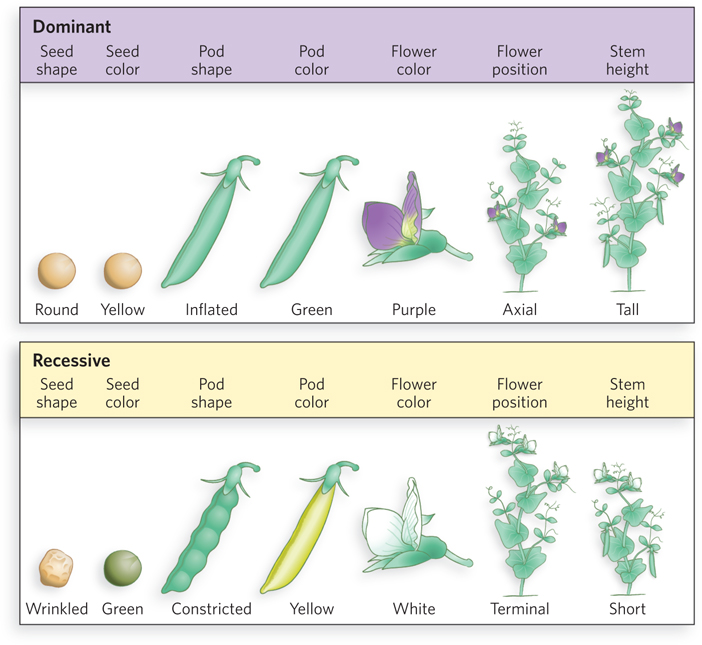
Figure 2-1: Traits of the garden pea examined by Mendel. Mendel picked seven pairs of traits to study: seed shape, seed color, seed pod shape, seed pod color, flower color, flower position along the stem, and stem height. The dominant and recessive forms of the traits are shown.
Mendel’s First Law: Allele Pairs Segregate during Gamete Formation
Mendel spent the first two years growing different varieties of peas to ensure that each was a true-breeding, or purebred, with the offspring produced by crossing two plants of the same variety always having the same appearance as the parents. Then he carefully selected seven different pairs of traits and cross-pollinated plants with contrasting traits. For example, plants with round seeds were crossed with plants having wrinkled seeds. The parental plants are referred to as the P generation (P for parental). The hybrid offspring are called the F1 generation (F for filial, from the Latin for “son or daughter”; F1 indicating first filial). This first generation produced only round seeds; the wrinkled-seed trait seemed to have disappeared. Mendel observed a similar result in crosses for all seven pairs of traits (Table 2-1). He referred to the trait that appears in the F1 generation as the dominant trait, and the trait that disappears as the recessive trait (see Figure 2-1).

Figure 2-1: Results of Mendel’s Single-Factor Crosses
Mendel’s finding that one trait is dominant and the other is recessive was novel and completely contrary to the prevailing view that parental traits blend together in the offspring. Other experimenters might have stopped at this new and dramatic discovery, but not Mendel. In his next experiment, he allowed F1 plants to self-pollinate and produce the F2 generation (second filial generation). Surprisingly, the F2 generation was a mixture: most plants produced round seeds (the dominant trait), but some had wrinkled seeds. The recessive wrinkled-seed trait that disappeared in the F1 generation reappeared in the F2 generation! In contrast to the view that parental traits blend in the offspring, Mendel did not observe a blending of the traits he studied. For example, there were no partly wrinkled seeds, and seed colors were either yellow or green, not yellow-green.
Unlike other scientists before him, Mendel kept close track of the numbers of offspring with the dominant and recessive traits. He counted 5,474 dominant round seeds and 1,850 recessive wrinkled seeds in the F2 generation, for a ratio of 2.96 dominant to 1 recessive trait. His experiments examining seed color produced a similar result. He observed 6,022 dominant yellow seeds and 2,001 recessive green seeds, for a ratio of 3.01:1. The other pairs of traits also appeared in a 3:1 ratio of dominant to recessive offspring in the F2 generation, as summarized in Table 2-1.
Mendel’s interpretation of these results was brilliant. Reappearance of the recessive wrinkled-seed trait in the F2 generation suggested that traits do not really disappear. Mendel therefore proposed that traits are “hereditary particles”—now called genes—and that they come in pairs. Organisms that carry two copies of each gene are diploid, and the different variants of a given gene are called alleles. In other words, a diploid parental plant has two alleles of the seed-shape gene (for example, one for smooth seeds and one for wrinkled seeds). Furthermore, Mendel proposed that one allele could mask the appearance of the other. This explained why traits could disappear but then reappear in future generations. Even though the F1 plant carried one dominant allele (round seed) and one recessive allele (wrinkled seed), only the dominant round-seed allele is evident in the outward appearance, or phenotype, of the F1 plant. Mendel also reasoned that each parent contributes only one copy of each gene to the offspring; that is, the gamete cells are haploid, having only one allele of each gene. When two F1 generation gametes combine and each carries the recessive allele for seed shape, the resulting F2 plant will produce wrinkled seeds.
We have introduced several genetic terms in the preceding paragraphs. These terms, and others that follow, are part of the scientific language of genetics and are defined in Table 2-2.
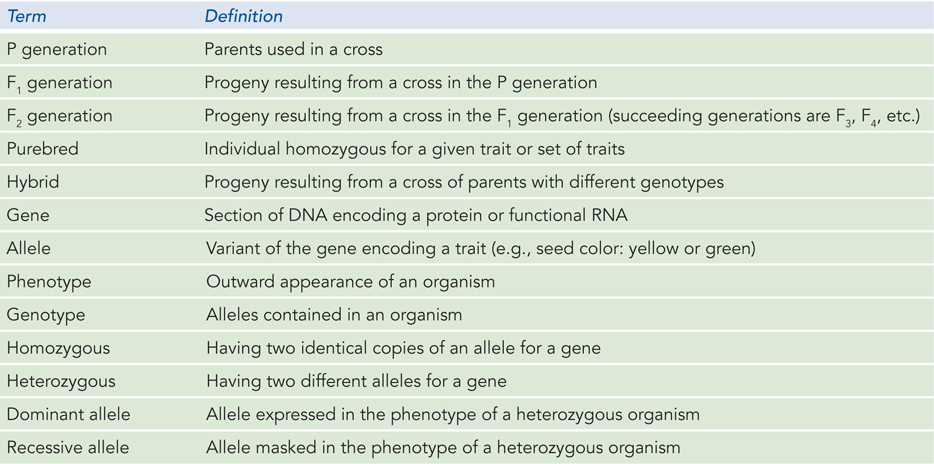
Figure 2-2: Commonly Used Terms in Genetics
Mendel was well-trained in mathematics, which helped him make sense of his results. To explain the ratios of phenotypes in the offspring in mathematical terms, he referred to the dominant allele with a capital letter (e.g., R for round) and to the recessive allele with the lowercase version of the same letter (r for wrinkled). A lowercase w might seem more fitting for the wrinkled-seed allele, but using different letters would make it harder to keep track of allele pairs of the same gene. A purebred round-seed plant has two R alleles, RR, and a purebred wrinkled-seed plant has two recessive alleles, rr. RR plants exhibit the dominant R trait (round seeds), and rr plants exhibit the recessive r trait (wrinkled seeds). This double-letter nomenclature, representing the allelic makeup of an organism, is a way of denoting the organism’s genotype.
In a cross of purebred parents, round (RR) and wrinkled (rr), all F1 progeny receive one allele from each parent and are thus Rr. The R allele is dominant to the r allele, so all F1 Rr hybrid plants have round seeds. The F1 plant produces R and r gametes in equal amounts, and therefore self-pollination of F1 plants produces three different diploid genotypes: RR, Rr, and rr. A convenient way of displaying the genes that come together during a cross such as this is a Punnett square analysis (Figure 2-2). In this analysis, the gamete genotypes of one parent are written along the top of the Punnett square, and those of the other parent are written along the left side of the square. The various combinations in which the alleles can come together during pollination are entered in the grid. The results yield the three different F2 genotypes in the following ratios: 1 RR, 2 Rr, and 1 rr. These genotypes, together with the concept of dominant and recessive alleles, explain the ratio of phenotypes that Mendel observed: 3 dominant (1 RR + 2 Rr) to 1 recessive (1 rr). We now refer to an organism with identical alleles for a given gene as homozygous for that gene (such as RR or rr). An organism with two different alleles, such as an Rr plant, is characterized as heterozygous.
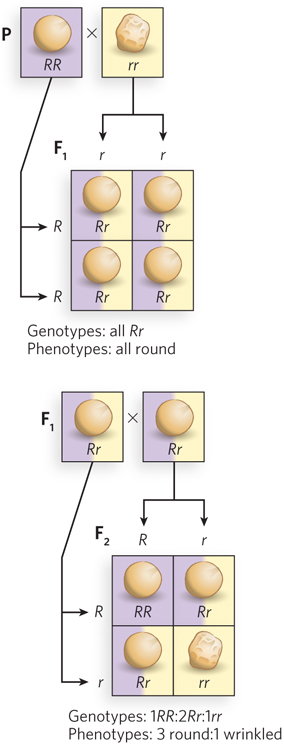
Figure 2-2: An example of Mendel’s first law. Alleles of the same gene segregate independently into gametes. Plants that are homozygous for dominant round-seed shape (RR) were cross-pollinated with homozygous recessive wrinkled-seed plants (rr) to produce F1 progeny. The Punnett square analysis shows the gametes of each parent along the top and left side of the grid, from which—if the gametes are formed in equal amounts—one can predict the possible progeny and their frequency. Punnett square analysis is a common way of illustrating genetic crosses today, but was developed after Mendel’s work. In the F1 generation, the only progeny that can be produced are Rr hybrids. F1 plants were self-fertilized, and as the Punnett square analysis for the F2 generation predicts (based on the assumption that the different alleles (R and r) segregate independently into F1 generation gametes), round seeds and wrinkled seeds were produced in a 3:1 ratio.
To determine whether the F2 plants really were of three genotypes in a 1:2:1 ratio, Mendel analyzed the offspring of self-fertilized F2 plants (the F3 generation). The F2 recessive wrinkled-seed plants (25% of the total F2 plants) all bred true, giving only wrinkled-seed F3 progeny, and thus were homozygous rr. The dominant round-seed F2 plants were of two types. One-third (25% of the total) bred true; their offspring always produced round seeds, and therefore these F2 plants were homozygous RR. The remaining two-thirds of the round-seed F2 plants (50% of the total) produced F3 plants with round and wrinkled seeds in a 3:1 ratio, and therefore these F2 plants were heterozygous Rr. The analysis fit the 1:2:1 ratio for the F2 genotype exactly: 1RR:2Rr:1rr (see Figure 2-2).
In summary, Mendel hypothesized that traits are carried by particulate genes, that somatic cells contain two copies (two alleles) of each gene, and that gamete cells obtain only one allele for each gene during gamete formation. When two gametes fuse at fertilization, allele pairs are restored, producing the diploid genotype of the offspring. The general principle summarizing this proposal is often referred to as Mendel’s first law, or the law of segregation, which states that equal and independent segregation of alleles occurs during formation of gamete cells.
Mendel’s Second Law: Different Genes Assort Independently during Gamete Formation
Mendel’s results demonstrated that two alleles for one gene separate during gamete formation, but how do alleles for two different genes behave? There are two possibilities. Alleles for two different genes could separate during gamete formation, assorting randomly into the gametes. Alternatively, they could remain associated, traveling together into the same gamete cells. These two scenarios have distinct outcomes. For example, if particular alleles for seed shape and seed color stay together during the formation of gamete cells, future offspring will retain both the same seed shape and the same seed color as one parent or the other. But if alleles for the two genes separate during gamete formation, some of the F2 offspring will exhibit new combinations of seed shape and color, distinct from those of either parent.
To test these hypotheses, Mendel’s next experiments were two-factor crosses, analyzing the transmission of two different genes in each cross. He began by cross-pollinating purebred plants having round, yellow seeds with plants having wrinkled, green seeds. First let’s consider the genotype of the two plants. We already know that the round-seed allele (R) is dominant to the wrinkled-seed allele (r). The genotype of the purebred plant with dominant yellow seeds is YY, and the purebred plant with green seeds is homozygous for the recessive green-seed allele, yy. Thus, the genotype of a purebred round, yellow-seed plant is RRYY, and the genotype of a plant with wrinkled, green seeds is rryy. A cross between these plants yields F1 progeny of genotype RrYy, phenotypically round and yellow. If the four alleles for the two genes separate and assort randomly during gamete formation, F1 plants will produce four different gametes (Ry, rY, RY, and ry), and all combinations of seed shape and color will be observed in F2 plants (Figure 2-3).
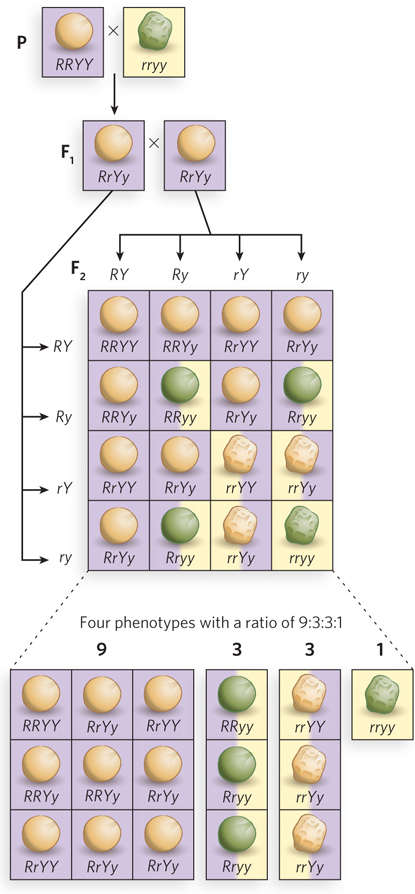
Figure 2-3: An example of Mendel’s second law. Different genes assort independently into gamete cells. The parental cross (round, yellow seeds x wrinkled, green seeds) yields uniform F1 progeny with the dominant phenotype (round, yellow seeds) and genotype RrYy. The Punnett square analysis assumes random assortment of the different alleles into the gametes formed by the F1 plant. All possible gamete genotypes are written across the top and left side of the grid. The predicted outcome for independent assortment is seeds of four different phenotypes in a 9:3:3:1 ratio, as illustrated below the Punnett square.
Mendel’s observations of F2 phenotypes are shown in Table 2-3. All possible combinations of traits occurred, and therefore the alleles of the two different genes are not physically connected; instead, they separate during the formation of gamete cells. The analysis of the four possible genotypes, as shown in Figure 2-3, predicts a 9:3:3:1 ratio, close to the observed result. Mendel performed many two-factor crosses analyzing different gene combinations, and the results were always consistent with the random assortment of genes during gamete formation. Mendel’s second law, or the law of independent assortment, states that different genes assort into gametes independently of one another.

Figure 2-3: Mendel’s Results from a Two-Factor Cross
Mendel studied garden peas, but his basic principles hold true for sex-based inheritance in all animals and plants. Indeed, many human genetic diseases that can be traced through a family pedigree follow Mendel’s simple rules of inheritance.
There Are Exceptions to Mendel’s Laws
The transmission of dominant and recessive traits documented by Mendel is sometimes referred to as “Mendelian behavior.” However, not all genes behave in such an ideal fashion. There are many exceptions to Mendel’s principles of heredity, a few of which we review here.
Incomplete Dominance Some alleles of a gene are neither dominant nor recessive. Instead, hybrid progeny display a phenotype intermediate between those of the two parents. This type of non-Mendelian behavior is called incomplete dominance. An example of incomplete dominance can be seen in the gene for flower color in four o’clock plants (Figure 2-4). Homozygotes are either red (RR) or white (R′R′; primed capitals are used so as not to confuse this case with recessive alleles), but the F1 heterozygote (RR′) is neither red nor white; it is pink. The molecular explanation for the pink heterozygote is the production of sufficient red color from the single R allele in the heterozygote to yield a pink coloration.
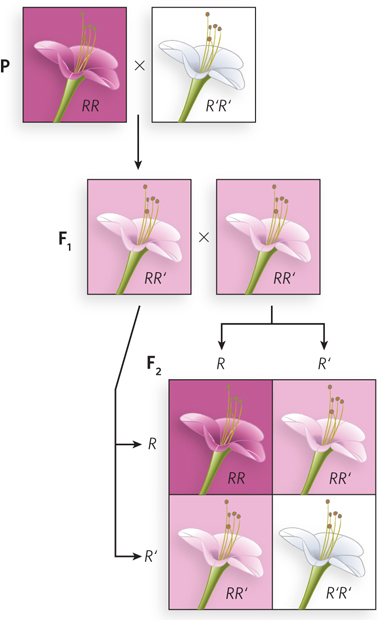
Figure 2-4: Non-Mendelian behavior: incomplete dominance in four o’clock plants. Cross-pollination of red- and white-flowered plants yields an F1 plant with flowers of intermediate color (pink). Therefore, neither parental allele is completely dominant. The single R allele gives rise to sufficient red pigment to produce a pink coloration. Genotypes are given below each flower.
Interestingly, an example of incomplete dominance can also be found in Mendel’s published work. He studied different alleles for the gene controlling the pea plant’s flowering time. The F1 progeny had a flowering time that was intermediate between the flowering times of the two parents.
Codominance Recessive alleles often produce nonfunctional proteins, or none at all. However, there are many examples of two alleles of a gene that produce two different functional proteins, neither of which is dominant to the other. This non-Mendelian behavior is known as codominance. An example of codominance is human blood type (Figure 2-5). The allele for A-type blood, IA, results in a cell surface glycoprotein different from the glycoprotein encoded by the allele for B-type blood, IB. People with A-type blood are homozygous IAIA, and those with B-type blood are homozygous IBIB. AB-type individuals are IAIB heterozygotes. O-type individuals lack both varieties of surface glycoprotein; they are homozygous for the recessive i allele.
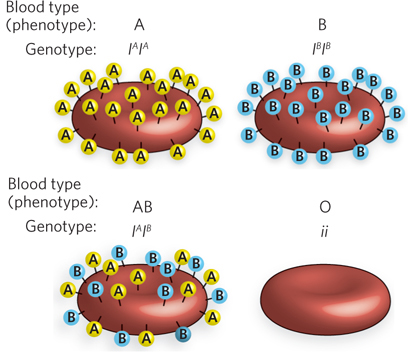
Figure 2-5: Non-Mendelian behavior: codominance in human blood types. The cell surface glycoprotein antigens on red blood cells (erythrocytes) determine human blood type. Two different alleles encode two variants of the enzyme glycosylase (an enzyme involved in formation of glycoproteins) and produce different cell surface glycoproteins, A (allele IA, yellow circles) and B (allele IB, blue circles). Both alleles are expressed in the heterozygote (AB blood type, genotype IAIB). Because both alleles produce functional surface glycoproteins, neither allele is dominant to the other. Individuals with O-type blood have two null alleles (ii) and thus produce no A or B surface antigens on their red blood cells.
Linked Genes The most common non-Mendelian behavior is seen in linked genes, in which alleles for two different genes assort together in the gametes, rather than assorting independently. We now know that genes are located on chromosomes, and diploid organisms have two copies of each chromosome, known as homologous chromosomes, or homologs. During gamete formation, whole chromosomes, not individual genes, assort into gametes. Genes that are close together on one chromosome are inherited together, contrary to Mendel’s second law. Assortment of linked genes into gamete cells is shown in Figure 2-6 and is discussed in detail later in the chapter.
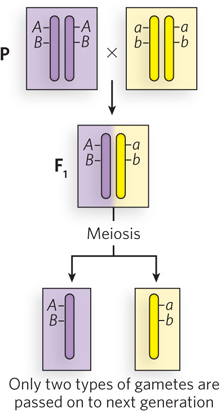
Figure 2-6: Non-Mendelian behavior: linked genes. Genes A and B are located on the same chromosome. Shown here is a cross between a homozygous dominant parent and a homozygous recessive parent that results in F1 hybrid progeny, all AaBb. Because the alleles for the two genes are close together on the same chromosome (A, B and a, b), they cannot separate during the formation of gametes. Each gamete receives one copy of this chromosome, and thus either the A and B alleles or the a and b alleles; no gametes containing A and b or a and B are formed. The two genes A and B are linked and do not assort independently during meiosis in the formation of gamete cells.
Mendel picked traits whose genes assorted independently. However, some of the genes that he studied are on the same chromosome. How could Mendel have observed independent assortment of genes on the same chromosome? As we describe later in the chapter, homologous chromosomes associate together during the cell divisions that lead to gametes. At that time, there is often an exchange of genetic material between the chromosome pair, resulting in some alleles previously found on one chromosome now being found on the other. For the traits Mendel selected for study, genes on the same chromosome are spaced far apart, and this swapping of genetic material occurs frequently between them. Therefore, the genes assort as though they are on different chromosomes.
Many other types of non-Mendelian behavior exist besides those described here. These include traits determined by multiple genes, traits derived from interactions between different genes (epistasis), the inheritance of traits encoded by organelle genes (cytoplasmic inheritance), and traits that depend on whether the gene is inherited from the male or female parent (genomic imprinting).
SECTION 2.1 SUMMARY
Mendel’s studies on the garden pea revealed an underlying mathematical pattern in inheritance.
Mendel postulated that genetic traits are carried by hereditary particles, now called genes. Diploid organisms contain two copies, or alleles, of each gene and produce haploid gametes that contain one allele for each gene.
Individuals homozygous for a particular gene have two identical alleles for that gene. In heterozygous individuals, the two alleles for a gene are different. The allelic makeup of an organism is its genotype.
The different alleles for a gene may be dominant or recessive. In a heterozygote, the dominant allele masks the recessive allele in the outward appearance, or phenotype, of the organism.
Mendel’s first law, the law of segregation, states that the two alleles for each gene segregate independently into haploid gamete cells.
Mendel’s second law, the law of independent assortment, states that alleles for different genes assort into gametes randomly. However, we now know that genes reside on chromosomes and that chromosomes, not genes, assort randomly into gametes.
There are exceptions to Mendel’s laws. For example, a gene exhibits incomplete dominance when the phenotype of heterozygous progeny is intermediate between those of the two homozygous parents. Gene alleles exhibit codominance when both produce functional proteins and neither is dominant to the other, as in human blood types. Alleles for two genes close together on the same chromosome are linked and do not assort independently into gametes.









